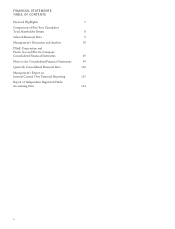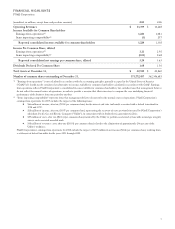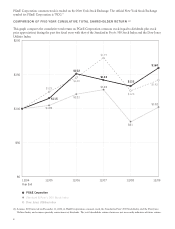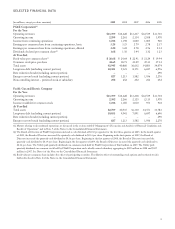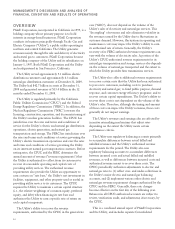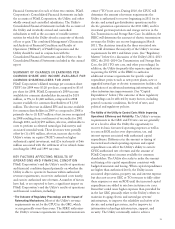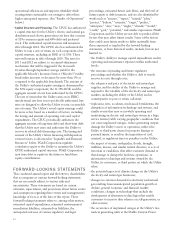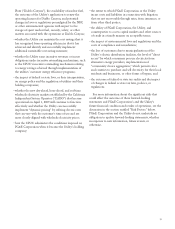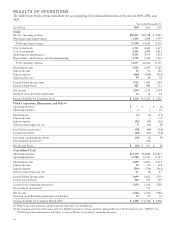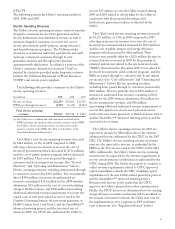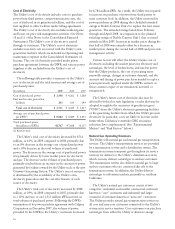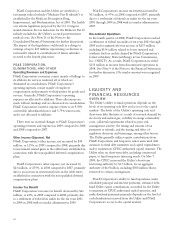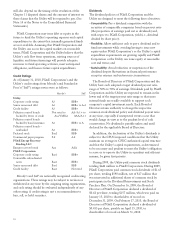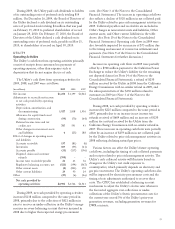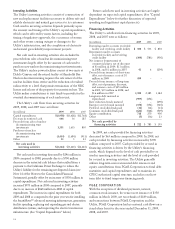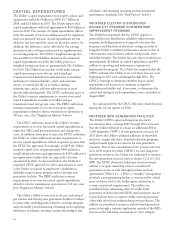PG&E 2009 Annual Report Download - page 20
Download and view the complete annual report
Please find page 20 of the 2009 PG&E annual report below. You can navigate through the pages in the report by either clicking on the pages listed below, or by using the keyword search tool below to find specific information within the annual report.
Cost of Electricity
The Utility’s cost of electricity includes costs to purchase
power from third parties, certain transmission costs, the
cost of fuel used in its generation facilities, and the cost of
fuel supplied to other facilities under tolling agreements.
The Utility’s cost of electricity also includes realized gains
and losses on price risk management activities. (See Notes
10 and 11 of the Notes to the Consolidated Financial
Statements.) The Utility’s cost of electricity is passed
through to customers. The Utility’s cost of electricity
excludes non-fuel costs associated with the Utility’s own
generation facilities, which are included in Operating and
maintenance expense in the Consolidated Statements of
Income. The cost of electricity provided under power
purchase agreements between the DWR and various power
suppliers is also excluded from the Utility’s cost of
electricity.
The following table provides a summary of the Utility’s
cost of electricity and the total amount and average cost of
purchased power:
(in millions) 2009 2008 2007
Cost of purchased power $ 3,508 $ 4,261 $ 3,288
Fuel used in own generation
facilities 203 164 149
Total cost of electricity $ 3,711 $ 4,425 $ 3,437
Average cost of purchased power
per kWh(1) $ 0.082 $ 0.089 $ 0.091
Total purchased power
(in millions of kWh) 42,767 47,668 36,157
(1) Kilowatt-hour
The Utility’s total cost of electricity decreased by $714
million, or 16%, in 2009 compared to 2008, primarily due
to an 8% decrease in the average cost of purchased power
and a 10% decrease in the total volume of purchased
power. The decrease in the average cost of purchased power
was primarily driven by lower market prices for electricity
and gas. The decrease in the volume of purchased power
primarily resulted from an increase in the amount of power
generated by facilities owned by the Utility such as the new
Gateway Generating Station. The Utility’s mix of resources
is determined by the availability of the Utility’s own
electricity generation and the cost-effectiveness of each
source of electricity.
The Utility’s total cost of electricity increased by $988
million, or 29%, in 2008 compared to 2007, primarily due
to a 32% increase, or an 11,511 million kWh increase, in
total volume of purchased power. Following the DWR’s
termination of its power purchase agreement with Calpine
Corporation in December 2007, the volume of power
provided by the DWR to the Utility’s customers decreased
by 8,784 million kWh. As a result, the Utility was required
to increase its purchases of power from third parties to
meet customer load. In addition, the Utility increased its
power purchases in 2008 during the scheduled extended
outage at Diablo Canyon Unit 2 to replace the four steam
generators. The extended outage lasted from February
through mid-April 2008, in comparison to the planned
refueling outage of Diablo Canyon Unit 1 that occurred
entirely in May 2007. Increases in market prices during the
first half of 2008 were entirely offset by a decrease in
market prices during the second half of 2008 and price risk
management activity.
Various factors will affect the Utility’s future cost of
electricity, including the market prices for electricity and
natural gas, the level of hydroelectric and nuclear power
that the Utility produces, the cost of procuring more
renewable energy, changes in customer demand, and the
amount and timing of power purchases needed to replace
power previously supplied under the DWR contracts as
those contracts expire or are terminated, novated, or
renegotiated.
The Utility’s future cost of electricity also may be
affected by federal or state legislation or rules that may be
adopted to regulate the emissions of greenhouse gases
(“GHG”) from the Utility’s electricity generating facilities
or the generating facilities from which the Utility procures
electricity. In particular, costs are likely to increase in the
future when California’s statewide GHG emissions
reduction law is implemented. (See “Environmental
Matters” and “Risk Factors” below.)
Natural Gas Operating Revenues
The Utility sells natural gas and natural gas transportation
services. The Utility’s transportation services are provided
by a transmission system and a distribution system. The
transmission system transports gas throughout its service
territory for delivery to the Utility’s distribution system,
which, in turn, delivers natural gas to end-use customers.
The transmission system also delivers natural gas to large
end-use customers who are connected directly to the
transmission system. In addition, the Utility delivers
natural gas to off-system markets, primarily in southern
California.
The Utility’s natural gas customers consist of two
categories: residential and smaller commercial customers
known as “core” customers and industrial and larger
commercial customers known as “non-core” customers.
The Utility provides natural gas transportation services to
all core and non-core customers connected to the Utility’s
system in its service territory. Core customers can purchase
natural gas from either the Utility or alternate energy
16


